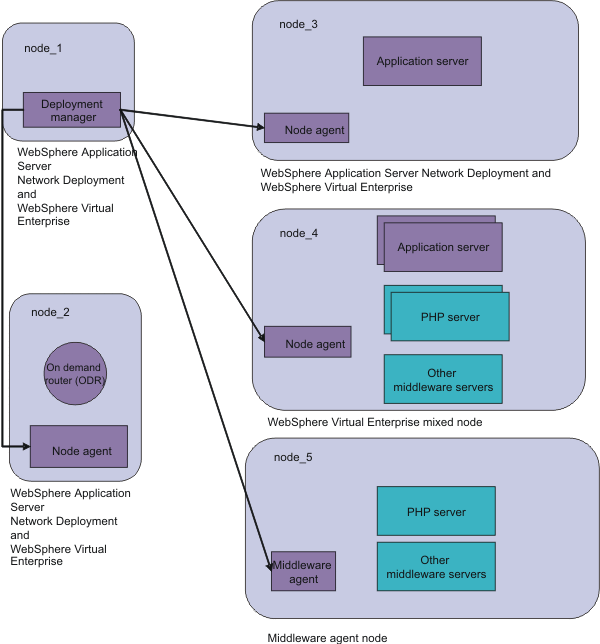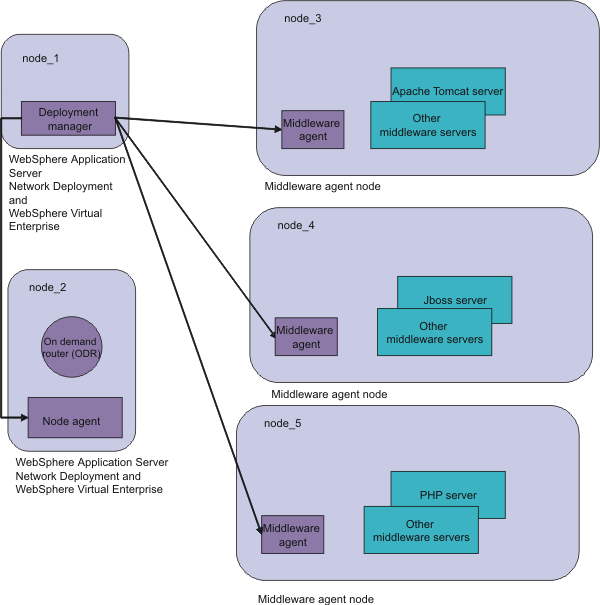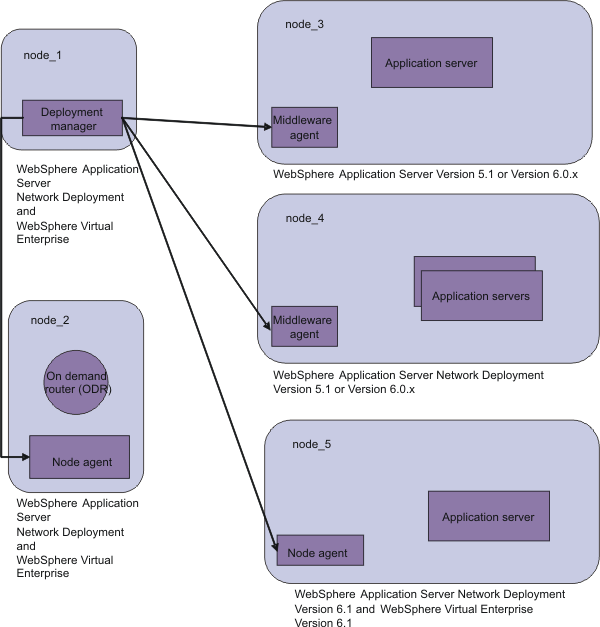Middleware agent
The middleware agent is a server process that is used to manage servers that are not running WebSphere® Virtual Enterprise.
The remote agent versus the middleware agent
In WebSphere Extended Deployment V6.0.x, limited support for servers that are not running WebSphere XD was provided. With the remote agent that was provided with the mixed server environment offering, generic server cluster could be configured to route work to these other server types. The remote agent monitors the external node and sends CPU utilization, node speed, and number of CPUs information to the autonomic controllers. With this configuration, application placement is not supported.
WebSphere Virtual Enterprise Version 6.1 extends this support with the middleware agent. The middleware agent replaces the remote agent.
Overview
The middleware agent can run on any node. You can install the middleware agent on a node that is running other middleware servers that were created outside of WebSphere Virtual Enterprise. You then can create representations of these nodes and servers and manage them in the administrative console.
Middleware agents have a framework with which they can communicate. The deployment manager can communicate with the middleware agents. The middleware agents must be at the same fix pack level as the deployment manager. Important: Middleware agents are not supported on the z/OS systems. You cannot federate a middleware agents from distributed platforms into a z/OS deployment manager.
Supported server types
When you install the middleware agent on a node, you can then manage the servers on that node with WebSphere Virtual Enterprise. The following server types are supported:- Apache HTTP Server V1.3, V2.0, and V2.2
- Apache Tomcat V4.1.x, V5.0.x, and V5.5.x
- Apache Geronimo V1.0 and V1.1
- JBoss V4.0.x
- BEA WebLogic Server V8.x and V9.x
- WebSphere Application Server Community Edition
- External WebSphere application servers, V5.1 and later.
- PHP V4.x and V5.x
To support any other server that supports HTTP traffic, you can create a custom HTTP server representation of the server in the administrative console.
Sample topologies for WebSphere Virtual Enterprise
The middleware agent is necessary for all of these servers to be managed by WebSphere Virtual Enterprise. The middleware agent is installed automatically on any WebSphere Virtual Enterprise machines. However, in a separate step, install the middleware agent on servers that run only other middleware servers. Configure the WebSphere Virtual Enterprise machines, then federate any other middleware servers to the WebSphere Virtual Enterprise configuration.
In the following topology example, a mixed environment is displayed. You are running WebSphere Virtual Enterprise machines, other middleware machines that run servers such as Tomcat or PHP, and mixed machines that include both WebSphere Virtual Enterprise and other middleware servers. On any nodes that are running WebSphere Application Server or WebSphere Virtual Enterprise, you can use the existing node agent to manage the node. On nodes that only run other middleware software, install the middleware agent.
Figure 1. Middleware agent topology: The middleware agent introduced into an environment that includes WebSphere products and other middleware software
 topology diagram: mixed environment" />
topology diagram: mixed environment" />
In the following topology example, WebSphere Virtual Enterprise is
introduced into an environment that was originally running only other middleware
server types. You install WebSphere Application Server
Network Deployment and WebSphere Virtual Enterprise on two nodes. These nodes become
the deployment manager and on demand router nodes. On your existing nodes
that run other middleware servers, you install the middleware agent.Figure 2. Middleware agent topology: Extended Deployment is introduced into an
environment that did not previously use any WebSphere products
 topology - WebSphere Virtual Enterprise introduced into an existing environment that previously ran only other middleware software" />
topology - WebSphere Virtual Enterprise introduced into an existing environment that previously ran only other middleware software" />
In the following topology example, some nodes
are running previous versions of WebSphere Application Server.
The middleware agent is required on any node that is not federated to the
deployment manager. In the following example, node_3 and node_4 are not federated
to the node_1 deployment manager, and have the middleware agent installed.Figure 3. Middleware agent topology: Multiple versions of WebSphere Virtual Enterprise
and WebSphere Application Server

Related tasks
Preparing the hosting environment for dynamic operations
Federating middleware nodes
Creating PHP servers and PHP dynamic clusters
Adding middleware servers to configurations